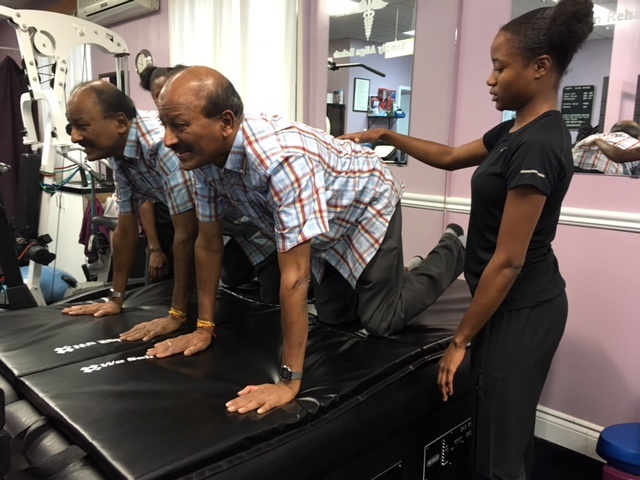Examination Date: 10/10/2017
Initial Exam
Chief Complaints
Frequent bilateral lower back pain. Patient complains of lower back pain since April with little to no improvement. CT scan of the lumbar spine demonstrates degeneration of lumbar spine with right lateral disc protrusion at L5-S1. The pain is described as aching and dull. He considers this condition as moderate and rated the pain as a 7 on a scale of 0 to 10 with 10 being the worst. The pain radiates into the right buttock, right calf and right foot. The pain is reduced by resting while bending and lifting aggravates the condition.
History
Mr. YYYYYY states that he currently has diabetes.
Capabilities of Daily Living
The patient states that capabilities of daily living have been affected in the following areas:
Due to pain, I am not able to lift heavy objects. However, light to medium weight objects are manageable. I experience MODERATE pain, which causes a significant limitation on my physical performance of activities. Pain is FREQUENT, and occurs between 50% and 75% of my awake time.
Physical Examination
Physical examination revealed an individual who was alert, cooperative and orientated.
The patient’s gait appeared normal. Minor’s sign was negative.
Sex: Male
Age: 63
Height: 170 cm
Weight: 64 kg
BMI: 22.1
Complexion: Normal
Size: Normal
Grip strength: Normal bilaterally.
Posture
There is no indication of a head tilt in the patient’s posture. His shoulder level appeared even bilaterally. There is no evidence of a forward head carriage. His ilium level appeared even bilaterally. Observation and inspection of the thoracic spine revealed a normal spine. Profile view of the lumbar spine revealed normal curvature. Romberg’s test was negative. Adam’s sign was negative. Left heel walk: WNL. Right heel walk: WNL. Left toe walk: WNL. Right toe walk: WNL. Trendelenberg test on the left was negative. Trendelenberg test on the right was negative.
Ranges of Motion
Lumbar Spine
Motion Degree Pain Level
Flexion: Moderately Decreased Moderate
Extension: Moderately Decreased Moderate
Lateral Right: Moderately Decreased Moderate
Lateral Left: Moderately Decreased Moderate
Neurological Testing
Reflexes Wexler’s Grading System
L R
Patellar (L2, 3, 4) 1+ 1+
Achilles (S1, 2) 1+ 1+
Lower Extremities:
Left Right
L-4 Equal
L-5 Decrease
S-1 Decrease
Lumbar Spine Evaluation
Lumbar spine evaluation provided the following results:
Evaluation of the lumbar spinal region reveals tender areas in the lumbar region on both sides (grade 2) and erector spinae on both sides (grade 2). Palpation of the spine indicated discomfort and pain in the spinous process at: L4, L5 and S1 (grade 2). Evaluation of the lumbar spinal areas indicates that trigger points are present in the erector spinae bilaterally (moderate) and quadratus lumborum bilaterally (moderate). Straight leg raise was positive on the right. The patient also reported experiencing radiating pain during the test. Braggard’s sign was negative bilaterally. Hoover test result was negative. Kemps was positive on the left. Kemps was positive on the right. Patrick-Fabere test was negative on the left and the right. Milgram’s test was negative. Valsalva’s test was negative. The following lumbar orthopedic tests were negative: hip circumduction bilaterally.
Lower Extremities Muscle Testing
Mr. YYYYYY demonstrated L5 (big toe extension) of 5 lbs on the right and12 lbs on the left.
Diagnosis
M5416 Radiculopathy, lumbar region
Subacute, moderate traumatic joint and muscle dysfunction in the above region with associated symptoms of pain, ROM reduction and functional difficulties.
Management Plan
Short Term Goals would be for patient to report 50% pain reduction and 50% increase in ROM within 2 weeks. Functionally patient should also be able to perform half of his ADL’s within these 2 weeks easier. Long Term Goals would be for patient to report over 80% pain reduction and demonstrate over 80% increase in ROM within 4 to 6 weeks. Functionally patient should also be able to perform most of his ADL’s within this period. Patient is also to be discharged with a home exercise program when the above goals have been achieved and he is over 80-90% impairment free.
Today’s Treatments
Chiropractic Spinal Decompression (Pron,6,55 lbs,0deg,15min NP) in the lumbar region; lumbar exercises (core training,10times, given by NP supervised by PTA)
Notes: Patient felt much better after the first treatment. We could have side bend the table to the right or extend to accommodate for right protrusion. But I left it at 0. Core stabilization is just as important of the decompression.
Also Read
| Case Study: Chronic Lumbar Spinal Stenosis (3) | Case Study: Chronic Lumbar Spinal Stenosis (3) | Case Study: Chronic Lower Back Pain | Case Study: L5-S1 Disc Prolapse |
| Case Study: Subacute Lower Back Pain | Case Study: Right lateral disc protrusion at L5-S1 | Case Study: Antalgic Posture | Degenerative Disc Disease (Intervertebral Disc Pain) |

